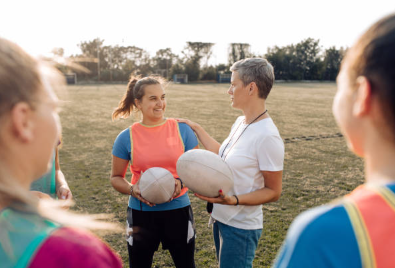Teacher to Teacher: Encourging Girls to Stay in Phsyical Education

Being a health and physical educator is rewarding. Your work has an impact on the lives of your colleagues, your students and their parents.
But it’s also a career with its challenges. We want our members to be able to connect and share how they handle the issues that come up in their classrooms and schools so we can all continue to learn and build our professional repertoires together.
In this section of the Journal, we feature questions posed by teachers (by way of social media or email), and answers directly from their colleagues.
Question:
We witness it ourselves and see it in the research: Girls opt out of physical education at a higher rate than boys. Given this, how can I motivate girls and young women to not just participate in physical education at our school, but to elect to take it in years to come?
Answer:
Greg Rickwood, Assistant Professor, Physical and Health Education Department, Nipissing University
There are two main factors associated with girls dropping out of physical education after Grade 9 are the lack of individual/lifestyle activities explored in traditional Grade 9 physical education classes, and the emphasis on competition and team games.
Keep it real
Offering activities such as yoga, zumba and even combative activities helps students connect school-based physical education to their daily lives. If teachers do not have expertise in these areas, they are encouraged to bring in fitness experts (could be a parent) or take students outside school boundaries to community pools, outdoor education centres, frisbee-golf courses, or hiking or skiing trails. When students make the connection between their daily lives and what they are doing in PE class, participation in school-based physical activities and generalized motivation towards physical activity may improve.
Include fun and choice
For game play at the end of units, consider a "recreational" stream and a "competitive stream." This allows students to choose the stream best suited to their skill set. It reduces social anxiety, particularly for girls, when they perceive their abilities to be equal or similar to their opponents, who might be thinking, "I actually have a chance to win." Many first year, high school females explain that they refuse to continue physical education beyond Grade 9 because "I was always on the bad team" or the "teacher always picked my partner." If teachers can enhance the daily enjoyment level of their students, the likelihood of retaining these female students beyond 9 improves significantly.
Allowing "choice" for girls is also a useful strategy for enrolment sustainability. Present a list of curriculum-based sports or activities that can be feasibly offered considering the school's space, equipment and proximity to community resources. At the start of a semester, ask the class to rank these activities, and as the teacher, try to accommodate the popular and culturally relevant selections. Also, allow grade 9 girls the room to be creative; Avoid structured rubrics and constraining success criteria where teachers teach to the test and instead focus on self-evaluation, peer-evaluation and student-centered rubrics where they design the criteria based on curricular expectations. Reducing performance anxiety during PE classes will improve enrolment numbers for girls in Grade 10.
Manage social dynamics
Girls can be intimidated by the change room dynamics, as well, that might include unsupervised situations leading to open criticism of student body types, degradation of clothing choices and the identification of the "haves" from the "have nots." It is crucial on the first day of class that teachers outline, in detail, and post in the changeroom the unacceptable behaviours and comments that fall under "zero tolerance." When these guidelines are broken, be swift and stern with the consequences and be sure to broadcast these consequences to the class. Alternatively, provide other options for changerooms where students cannot be subjected to the student "gaze" (i.e. teacher's washroom, empty team change room).
Establish connections
Finally, building professional relationships with your students — showing interest in their lives outside of PE, inviting their suggestions for activities, promoting student ownership in class outcomes (evaluation strategies, for example), or allowing students to be the teacher for the day — are all pedagogical strategies associated with girls’ sustained enrolment in physical education. Overall, be passionate and energetic about the physical education curriculum and it will inspire students to come back for more. Female physical education students respect a teacher's enthusiasm around the subject area and deeply value regular teacher modeling.
As an aside, develop productive and long-lasting relationships with the guidance department in your school as they can be the best recruiters when speaking to their student membership about career goals and relevant courses. They hold significant influence on a student's








